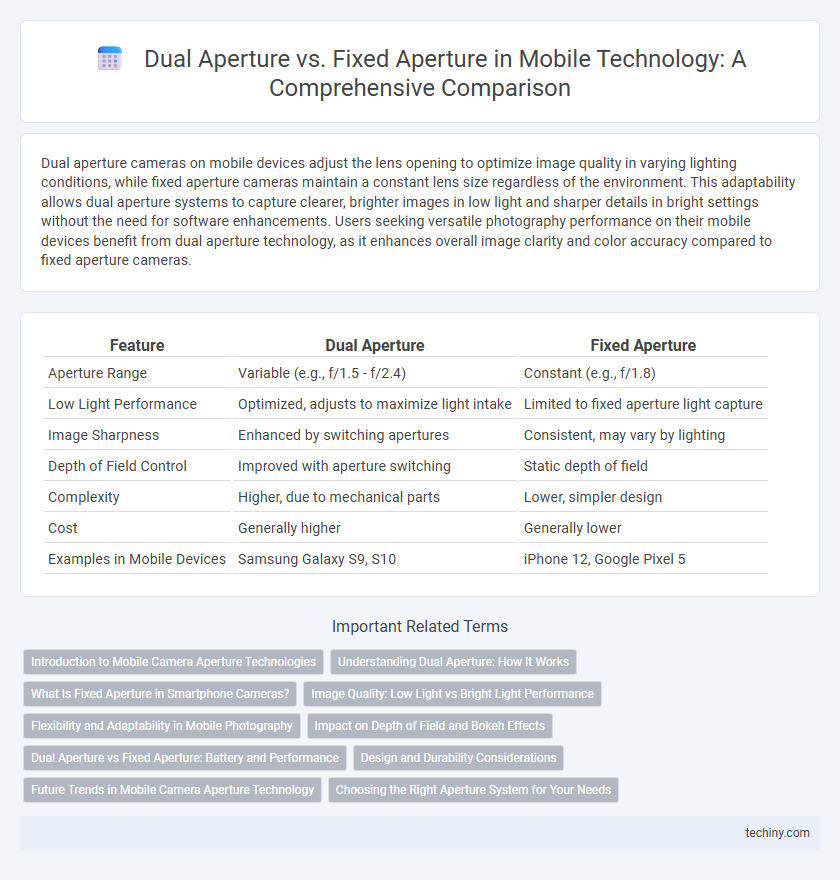Dual aperture cameras on mobile devices adjust the lens opening to optimize image quality in varying lighting conditions, while fixed aperture cameras maintain a constant lens size regardless of the environment. This adaptability allows dual aperture systems to capture clearer, brighter images in low light and sharper details in bright settings without the need for software enhancements. Users seeking versatile photography performance on their mobile devices benefit from dual aperture technology, as it enhances overall image clarity and color accuracy compared to fixed aperture cameras.
Table of Comparison
| Feature | Dual Aperture | Fixed Aperture |
|---|---|---|
| Aperture Range | Variable (e.g., f/1.5 - f/2.4) | Constant (e.g., f/1.8) |
| Low Light Performance | Optimized, adjusts to maximize light intake | Limited to fixed aperture light capture |
| Image Sharpness | Enhanced by switching apertures | Consistent, may vary by lighting |
| Depth of Field Control | Improved with aperture switching | Static depth of field |
| Complexity | Higher, due to mechanical parts | Lower, simpler design |
| Cost | Generally higher | Generally lower |
| Examples in Mobile Devices | Samsung Galaxy S9, S10 | iPhone 12, Google Pixel 5 |
Introduction to Mobile Camera Aperture Technologies
Dual aperture technology in mobile cameras dynamically adjusts the lens opening between two settings, optimizing light intake for diverse lighting conditions and enhancing image clarity. Fixed aperture lenses maintain a constant opening size, offering consistent exposure but less adaptability in low-light environments. The implementation of dual aperture enables improved photo quality by mimicking human eye adjustment, making it a significant advancement over traditional fixed aperture mobile cameras.
Understanding Dual Aperture: How It Works
Dual aperture technology enables smartphone cameras to switch between two different aperture settings, such as f/1.5 and f/2.4, to optimize light intake based on environmental conditions. This dynamic adjustment enhances image quality by allowing more light in low-light scenarios and providing sharper focus in bright settings, surpassing the limitations of fixed aperture lenses. The capability to automatically alternate apertures improves exposure control and depth of field versatility, resulting in clearer, more detailed photos.
What Is Fixed Aperture in Smartphone Cameras?
Fixed aperture in smartphone cameras refers to a lens opening size that remains constant, controlling the amount of light entering the camera sensor. Unlike dual aperture systems that switch between apertures for varying lighting conditions, fixed aperture cameras rely on a single f-stop value, such as f/1.8, to balance light intake and depth of field. This design simplifies the optical mechanism but may limit performance in extremely low light or high contrast environments.
Image Quality: Low Light vs Bright Light Performance
Dual aperture technology improves image quality by automatically switching between wide and narrow apertures to optimize low light and bright light performance, reducing noise and enhancing detail in diverse lighting conditions. Fixed aperture lenses have a constant aperture size, which can limit flexibility in exposure control, often causing issues like overexposure in bright light or loss of detail in low light. Smartphones with dual aperture provide better dynamic range and sharper images, especially in challenging lighting situations, compared to fixed aperture systems.
Flexibility and Adaptability in Mobile Photography
Dual aperture technology offers greater flexibility and adaptability in mobile photography by automatically switching between wide and narrow apertures to optimize exposure in varying lighting conditions. Fixed aperture lenses, while simpler and often faster, lack the ability to adjust dynamically, limiting performance in challenging environments such as low light or bright sunlight. This adaptability in dual aperture systems enhances image quality by balancing depth of field and light intake, making it a preferred choice for versatile mobile photography.
Impact on Depth of Field and Bokeh Effects
Dual aperture technology enhances depth of field control by switching between wide and narrow apertures, allowing for dynamic bokeh effects and improved low-light performance on mobile cameras. Fixed aperture lenses maintain a constant aperture size, limiting flexibility in achieving varied background blur and depth of field adjustments. The ability of dual aperture systems to adapt aperture sizes results in more versatile and aesthetically pleasing portrait photography with pronounced subject separation.
Dual Aperture vs Fixed Aperture: Battery and Performance
Dual aperture technology dynamically adjusts the lens opening between f/1.5 and f/2.4, optimizing light intake and enabling better low-light photography without excessively draining battery life. Fixed aperture lenses maintain a constant aperture, typically f/1.8 or f/2.0, which simplifies image processing but may consume more power during heavier post-processing in challenging lighting. Devices with dual aperture systems often balance battery efficiency and performance more effectively by intelligently switching apertures based on shooting conditions.
Design and Durability Considerations
Dual aperture cameras offer enhanced flexibility in varying lighting conditions by mechanically switching between apertures, but this complexity may impact long-term durability due to moving parts. Fixed aperture designs are simpler and more robust, reducing the risk of mechanical failure and improving durability under rigorous daily use. The trade-off between advanced functionality and structural reliability is a key factor in mobile camera module design.
Future Trends in Mobile Camera Aperture Technology
Future trends in mobile camera aperture technology emphasize advanced dual aperture systems that dynamically adjust between multiple aperture sizes for improved low-light performance and depth of field control. Innovations in computational photography coupled with variable aperture lenses enable seamless switching without mechanical limitations typical of fixed aperture designs. Integration of AI algorithms optimizes aperture settings in real-time, enhancing image quality and energy efficiency on next-generation smartphones.
Choosing the Right Aperture System for Your Needs
Dual aperture systems offer versatile performance by switching between wide and narrow apertures, enhancing image quality in varying lighting conditions, making them ideal for users who frequently capture photos in diverse environments. Fixed aperture lenses provide consistent exposure and sharper images in controlled settings, suitable for users prioritizing simplicity and reliability. Selecting the right aperture system depends on your photography style, lighting conditions, and the balance between flexibility and consistency you require.
Dual aperture vs Fixed aperture Infographic

 techiny.com
techiny.com